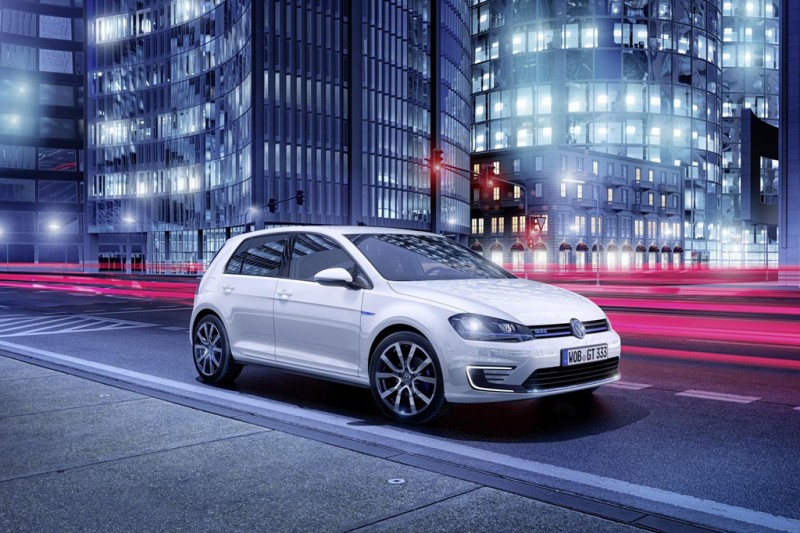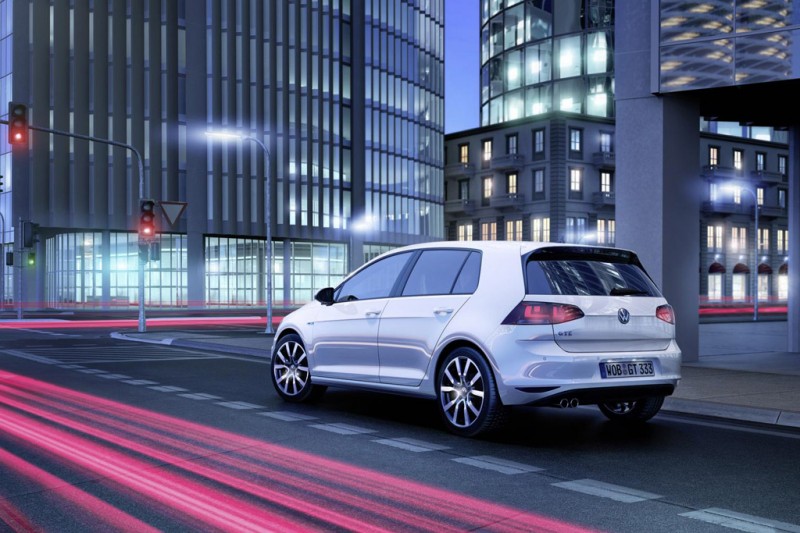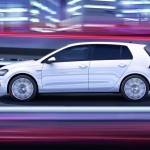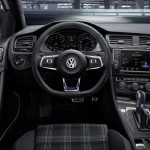Volkswagen claims to be the first automaker worldwide to be offering a model line with a full range of conventional and alternative powertrains including, petrol, diesel, CNG (natural gas), hybrid and all electric. The new Golf GTE plug-in hybrid will be presented at the Geneva International Motor Show (March 4 to 16, 2014). The Golf GTE has an NEDC hybrid combined fuel economy rating of 157 mpg (equivalent to 35 g of CO2) and has an all-electric range of 31 miles along with an overall range of 584 miles.
As with all electric hybrid vehicles, the new Golf GTE has two power plants: a 1.4-liter 148 horsepower turbocharged and direct-injection TSI engine and a 101 hp electric motor. These combine to provide the stated system power of 201 hp. If the electric motor is the sole source for propulsive power, the Golf GTE is capable of speeds up to 81 mph and an EV only range of 31 miles.
When the full power is needed, the GTE does a brisk 0 to 62 mph in 7.6 seconds and achieves a top speed of 135 mph on the German autobahn and, perhaps, race courses. More usable, is the torque of the new hybrid Golf. Providing 258 lb-ft total which ought to give it incredible pulling power and, Volkswagen say, sets it apart from other hybrids on the market.
Despite its power and torque, the Golf GTE remains one of the world’s most efficient cars. If you mainly run short distances, you can drive in emissions-free all-electric mode for days, weeks, and months. Volkswagen say the battery takes about three and a half hours to charge fully from a conventional wall outlet which we assume to mean they’re referring to slow charges which you can obtain for free at present due to the government grant. Indeed, Volkswagen state that using their wallbox or a more powerful public charging station will reduce charge times to around two and a half hours. Thanks to control options on the Golf GTE, the driver can also ensure that only the electric motor is used in an urban area, even when doing much longer trips.
Interestingly but quite apart from the new hybrid Golf itself, Volkswagen are touting a new term for their production methods employed when enabling so many different drivetrains to be installed in each Golf. Being able to install a plethora of acronyms like TDI, GTD, GTI and TGI as well as all electric drive in the e-Golf and now hybrid drive in the GTE, Volkswagen call this process “modular transverse matrix” which they’ve bizarrely shortened to; MQB. The point is that conventional production methods have had to be rethought as sticking a petrol or diesel drivetrain in a vehicle is one thing but installing an electric or hybrid drive in another is quite different and adds complexity to the production line. Volkswagen have managed to do this in such a way that, as they put it, “Golf models with petrol, diesel, natural gas, electric and hybrid drives can be manufactured from bumper to bumper at Volkswagen factories”
Back to the hybrid Golf itself, the electric motor is supplied with power from a high-voltage 8.8 kWh liquid-cooled lithium-ion battery that is charged from a socket behind the VW logo in the radiator grille. The battery weighs 120 kilos (265 lb), or about eight percent of the GTE’s 1524 kilo (3360 lb) curb weight. The GTE has a six-speed DSG automatic transmission that has been developed specifically for hybrid vehicles – expect to see the same setup in the Audi A3 e-tron.
Volkswagen integrated the electric motor in the transmission housing. Additional hybrid drive components also include the power electronics (which converts the battery’s DC to AC for the electric motor) and a charger. An electro-mechanical brake servo and an electric air-conditioning compressor safeguard optimal and energy-efficient operation of the brakes and air conditioning, especially for the GTE’s EV mode or “e-mode”.
The Golf GTE can be driven in various intuitively named modes. For instance, the driver can push a button to intentionally switch to e-mode” which makes the Golf GTE a zero-emissions vehicle, using only electric power. The driver can also use the button to switch to “GTE mode”, which activates the sporty side of this new Golf and uses the full combination of both electric and petrol power.
Exterior
Volkswagen Head Designer Klaus Bischoff’s crew created a look that merges GTI insignia with those of the e-Golf, creating an unmistakable identity. Klaus Bischoff explains the differences:
“The presence of the electric drive is visually expressed by the prominent C-signature of the daytime running lights on the Golf GTE. Meanwhile, all other front design elements bridge to the GTI.”
In those places where red dominates on the GTI, blue is used in the GTE. Bischoff continues:
“A radiator crossbar running into the headlights provides further sporty accents within the context of Volkswagen electric mobility.”
Like the e-Golf, the four-door Golf GTE will launch with LED dual headlights as standard. The turn signals, parking light, and smoked numberplate lighting also use LED technology. Side skirts and a roof-edge spoiler provide further parallels with the GTI and GTD. Meanwhile, the aerodynamic 16-inch (standard), 17-inch, and 18-inch aluminum-alloy wheels were designed especially for the GTE.
Interior
Like the exterior, the sporty interior of the Golf GTE reveals a clear relationship to its other two GT series counterparts. However, just as on the exterior, the interior’s red accents have also turned to blue. Klaus Bischoff says:
“Volkswagen’s e-mobility color of blue creates attractive contrasts in the car’s seating, decorative seams, and material design. Moreover, the blue ambience lighting builds a visual bridge to the world of e-mobility.”
The light blue decorative seams on the leather-wrapped steering wheel, on the edges of the floormats, on the seats, and on the shifter grip are perfectly matched with the exterior features of the Golf GTE.
Golf GTE-specific instruments and displays
Touchscreen: All Golf cars are equipped with a touchscreen. In the case of the Golf GTE the high-resolution 6.5-inch “Composition Media” radio system is standard. The “Discover Pro” radio-navigation system is available as an option. Both units are equipped with many additional functions on the GTE. These include a “driving range monitor”, an “energy flow display”, “zero emission statistics”, “e-manager”, and—with the optional navigation system—the “360° driving range”. Additionally, all Golf GTE owners can download the “Volkswagen Car-Net e-Remote” app to their smartphone free-of-charge and use it to control functions and access information.
Driving range monitor: Shows the current electric driving range of the GTE as well as the additional driving range potential from deactivating any auxiliary features that consume electricity.
Energy flow display: Shows the power flow when accelerating (blue arrows) and when braking or regenerating (green arrows) as animated graphics.
e-manager: Can program up to three departure and charging times; the Golf GTE ensures the set temperature and battery charge status at a defined time. Parallel to this, heating or cooling of the interior can be activated using standard air-conditioning while charging. Air conditioning therefore does not hinder the battery charging process, thereby extending the electric range.
360° range: The current radius in “e-mode” is shown by the 360° range in the local map. The inner area shows the range for an outward and return trip, the outer area the range for a one-way drive. Charging stations can be displayed and incorporated in the route as intermediate stopovers.
Car-Net e-Remote: Using the “Volkswagen Car-Net e-Remote” app it is also possible to make several of these settings and requests for information via a smartphone or the Car-Net website. In detail, the app can program the departure time, air conditioning, charging the battery, accessing vehicle data, and the vehicle’s status.
Power meter: The power meter supplements the tachometer on the left-hand side of the instrument cluster; it displays how much system power is currently being used or the intensity of battery regeneration. The speedometer remains on the right-hand side. The color display which is located between the power meter and the speedometer (multifunction display “Plus”) also permanently shows the electrical driving range and the current operating mode.
Source; Volkswagen




